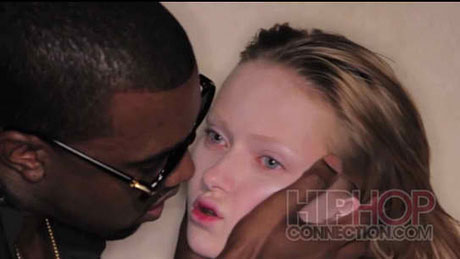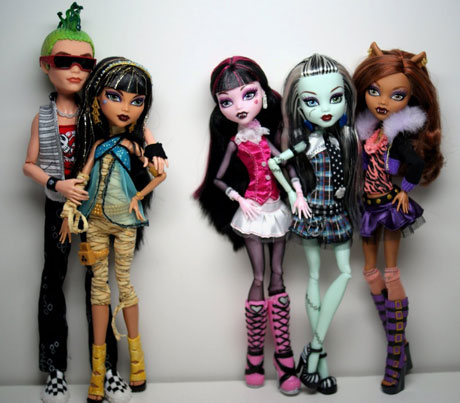I write this in solidarity with the millions who recently marched throughout Europe calling for the media's recognition of women's dignity. The march, which began in Italy, called for Italian Prime Minister Silvio Berlusconi's resignation using the slogan; “If not now, when?” It seems we are light years from this sort of action in the United States. Anyone can besmirch women's media image because there is an unspoken justification based on the individual's “choice.” The big picture of how women's public debasement affects everyone who consumes it continues, for the most part, to be unacknowledged and uncontested.
I help consumers deconstruct media through media literacy, and it makes me wonder what the take-home message will be from Kanye West's “Monster” video. His video is not alone in its hatred and is not by a long shot the most disturbing. Yet, it comes from a beautiful, wealthy, talented, black man whose desire for racial justice appears genuine. Will viewers think violence toward females is normal or that being sexually aroused by lifeless, naked, zombie-like females is hot? Will parents watch the video and use it as an opportunity to begin a difficult discussion about intimacy and how the media distorts it? There is no one answer.
The unfinished “Monster” video includes scenes with rapper Rick Ross wearing a smoking jacket and sitting among white women, who hang in lynch-like fashion from his ceiling. The dead bodies wear little save the high heels dangling from their feet, and the bodies swing lightly, as if by a gentle breeze, as his cigar smoke wafts around them. In another preview video, Ross is seated at the head of a dining table eating what looks to be bloody innards. A dead woman lies spread-eagled on the table, her crotch opened toward his plate. Women of color are portrayed as monsters, werewolves and zombie schoolgirls jumping rope. A fully naked dead woman lies, legs akimbo, on a couch, wearing red heels as Jay-Z, who dons a classy suit and tie, raps in the foreground. There is a cannibal scene of two vampires of color, on all fours, eating what appears to be the body of a white (or Asian?) waiter. In another scene, West plants an up-close kiss on the puckered lips of a blonde female corpse who lies on a bed alongside another dead woman. West holds a woman's decapitated head, a disembodied hand lays on the ground in other scenes.

The old days of hip-hop, booty-shaking, three-minute videos are being replaced with 18-minute epics, in which consumer products glare at viewers in David-LaChapalle Technicolor (see Gaga and Beyonce's “Telephone” video). There is MIA's “Born Free” music video, whose theme centers on the gathering and execution of redheads, including a slow-motion, point-blank execution of a young girl. Then we have Rihanna's and Eminem's popular duet, amid scenes of partner battery, which explodes into flames as Eminem raps, “If she ever tries to leave I will f—ing tie her to the bed and set this house on fire.” To which Rihanna, who recently left a real-life battering relationship, responds with, “Are you gonna stand there and watch me burn? That's okay, because I like the way it hurts. Are you gonna stand there and hear me cry? That's alright because I love the way you lie.”
Given what young people consume as “entertainment,” the “Monster” video's theme fits right in. Popular media entertainment is filled with themes of half-dead zombies, sexy werewolves, and more. There is “True Blood,” “The Vampire Diaries,” the “Twilight” series, vampire music and, now, girls are pitched monster dolls. Ms. magazine quoted Tim Kiplin, general manager for Mattel, speaking on his dolls' favorite activity, “Shopping and flirting with the boys!” Even half-dead girls embody the status quo.

Hollywood has long worshipped death, violence and humiliation over love, justice and healing: Thanatos over Eros. Violence is an easy sell and translates well into foreign markets. Consider how ingrained this acceptance of violence is when it is exemplified by how parents will allow their young children to witness thousands of televised and video murders. but believe witnessing an actual birth would be far too traumatic for a child.
When West's lyrics repeat, “Everybody knows I'm a mutha-f—-ing monster,” is it because he is surrounded by death and flesh-eating zombie types, or is he correctly acknowledging how black males are unfairly demonized in the media and in reality? If his call is for racial justice, then his point is well taken. All people of color suffer from unfair media portrayals. DC has a holocaust museum documenting the Nazi death camps and a Native American museum. But where is a museum dedicated to horrors of American slavery that includes the funneling of our black youth into prison or into wars waged against the will of the majority? The Smithsonian is working on a museum to recognize the contributions of African-Americans, but an American slavery museum could be an especially important step toward social change. According to Arun Gupta, “There is the post-Civil War history of KKK terror, 1,322 documented lynchings from just 1890-1902, repeated incidents of deadly ethnic cleansing of Black enclaves in Midwestern and Southern towns in the early 20th century, and the vicious white backlash in the Civil Rights era.” We should all work to expose this sordid history and work to end the oppression that has many people of color falling through the economic safety nets today.
A scene from West's video, “Runaway,” includes an elegant dinner table filled with impeccably dressed African-Americans, served exclusively by white servants, a refreshing meme disrupter we need more of. And, Kanye West's comment during hurricane Katrina's aftermath that George Bush doesn't like black people, seems downright polite given the circumstance. Yet, I can't forgive or forget all those dead women.
Are these white women who hang like “strange fruit” from the black rapper's ceiling his idea of payback? Black men were lynched for merely looking at a white women. Is this West's idea of revenge? He is now rich enough to pay white women to strip their clothes and play dead, and to pay women of color to play zombies and flesh-eating vampires. If West's concern is for racial justice, then why must he sexualize the victimization of women on his path to freedom and fortune?
Latonya Peterson, from the blog Racialicious, notes that all the flap being generated over West's video doesn't take into consideration that only white women are dead. She correctly points out that we live in a culture that rarely treats the murder or death of a female of color with the same coverage and consideration it does toward a white female. She notes that all the women of color are alive even though they are monsters, werewolves, zombies, or flesh-eating vampires. Ms. Peterson writes:
In some ways, the conversation around dead women in Kanye's video reminds me of the conversations that happen around feminism and black women. The reality of black women is assumed to be exactly the same as white women – if it is mentioned at all. The fact that the majority of the women pictured lying dead were white, while black women are all part of the monster crew is generally not mentioned.
So, I'm not surprised that no one has looked at the very specific positioning of white women in the video as opposed to black women, which dives deeply into the history and construction of black women as beast-like and fearsome, the sexualization of violence, and how the video is a win for both normalized misogyny and upholding the ideals of white supremacy.
But I would be remiss if I didn't mention that the intent and response are very different things. While Nicki Minaj is easily the woman with the most agency in the video, she is still reduced to being the target of a simplistic male gaze. I've written about this before, noting that hip-hop's visual culture has (d?)evolved to the point where female rappers are also required to serve as eye candy in their own music videos, an action not required of men in a similar position.
Women walk an increasingly impossible tightrope: we mustn't be too sexy else we are blamed for any sexual abuse we receive. We mustn't be too plain or we are dismissed as man-hating lesbians. Being sexy for women is often equated with being submissive, passive, even silent. Wearing popular high heels is best attempted when standing very still. Women also learn that their appeal is enhanced by being out of it, drunk or drugged. A natural extension of this thinking has led to the sexual appeal of totally lifeless, dead women. The Internet is full of web sites featuring women who play dead for male masturbatory purposes. Even “America's Next Top Model” asked their contestants to pose as sexualized corpses. It's time to discuss the impact of these portrayals, even though the media loves to silence these discussions with accusations of being anti-sex prudes. Women's battle for true sexual autonomy and choice is rarely given the debate it deserves. The silence is killing us.We wish rich, powerful, men like West would wake up. To advance human rights and dignity for all people, we must stand united. If West had hung baby polar bears there would be such an outcry that “Monster” would be shut down. But because West chose a group that the media presents as deserving of such public debasement, it causes little opposition. Mainstream media constantly teaches people that while the dangling corpses appear dead, these women obviously consented, and were paid to hang, paid to eat flesh. Making it about one person's “choice” over the impact this choice has on millions, sadly ends our need for further discussion. And calling attention to horrid examples only gets more people interested in whatever offensive image is out there.
Kanye has repeatedly said he wants his material banned and censored, following the formula that any publicity is good publicity. Those of us who want the media to stop making violence against women sexy, understand that our educational moments benefit West and others like him. The more successful our petition to stop Kanye's video, the bigger the buzz. Media Watch has always been opposed to censorship, because we believe it doesn't work. Education, on the other hand, is the key. We move a thimble full of water from the vast sea of hate trying to convince ourselves if one person wakes up, it is worth the continued effort.
Our most important fundraising appeal of the year
December is the most critical time of year for Truthout, because our nonprofit news is funded almost entirely by individual donations from readers like you. So before you navigate away, we ask that you take just a second to support Truthout with a tax-deductible donation.
This year is a little different. We are up against a far-reaching, wide-scale attack on press freedom coming from the Trump administration. 2025 was a year of frightening censorship, news industry corporate consolidation, and worsening financial conditions for progressive nonprofits across the board.
We can only resist Trump’s agenda by cultivating a strong base of support. The right-wing mediasphere is funded comfortably by billionaire owners and venture capitalist philanthropists. At Truthout, we have you.
We’ve set an ambitious target for our year-end campaign — a goal of $250,000 to keep up our fight against authoritarianism in 2026. Please take a meaningful action in this fight: make a one-time or monthly donation to Truthout before December 31. If you have the means, please dig deep.
